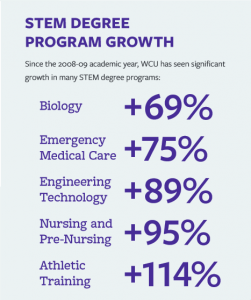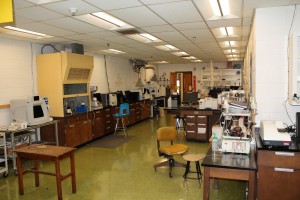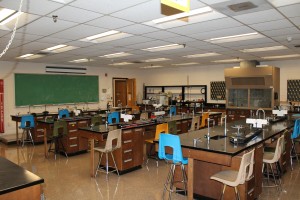Western Carolina University Chancellor David O. Belcher will host an educational forum beginning at 12:30 p.m. Monday, Feb. 29, to address the regional importance of the Connect NC bond proposal. The event will be held in the theater of WCU’s A.K. Hinds University Center.
On Tuesday, March 15, North Carolina voters will decide on the $2 billion referendum, which would fund state and local infrastructure needs, highway projects and state parks improvements, and provide $110 million for a new WCU Natural Sciences Building.
Speakers will include Belcher, who will address how bond approval would help communities in Western North Carolina, and students representing the Student Government Association, College Republicans and College Democrats. The event includes a question-and-answer period.
WCJ published this story on Dec. 17, 2015 on the need for new science building and we are republishing it now.
WCU is making plans for a new Natural Sciences building to accommodate the increasing number of students pursuing degrees in science, technology, engineering and math (STEM) programs.
The current Natural Sciences building was constructed in the 1970s, making it incompatible with modern teaching styles and technology.
Today, WCU has approximately 2,300 health and human sciences students, 600 technology and engineering students and 500 biological and physical science students according to ‘The Case for a New Natural Sciences Building at Western Carolina University’.
“When the building was built, Western had about 6,100 students and 60 percent of those were education majors,” said Richard Starnes, dean of the College of arts and sciences.

Official table taken from ‘The Case for a New Natural Sciences Building at Western Carolina University.’
Indrani Bose, Ph.D., has been an associate professor of biology at WCU since 2007. According to Bose, there are several components of the Natural Sciences labs that need improvement.
“All the science spaces really need a complete redo, not just a facelift,” said Bose.
The new Natural Sciences building will offer better flexibility, technology and collaboration space for students.
“We would like to see a better planned building, where the things we do have can be better accessed and utilized,” said Bose. “We’d also like to see some common areas for students and faculty to gather.”
“The spaces will be much more flexible,” said Starnes. “There will be more opportunities for undergraduate research. There will be more opportunities for student-faculty collaboration and they will be able to use the latest equipment that they will use later in their career. We have much of that equipment now, but the nature of the architecture means that students often have to go from room to room in order to engage in a laboratory for a particular course.”

One of the labs in Natural Sciences shows the conflict between modern equipment and outdated architecture. Photo by Edgar Nye.
Not only will the new building accommodate a growing student population, but it will also improve the education of current students by solving problems caused by the current building.
“We have a problem with lab space,” said Starnes. “Right now, the Natural Sciences building is arranged in such a way that it reflects 1970s pedagogy. You have a blackboard at the front and fixed benches where the professor would do an experiment and you would repeat the experiment. That’s not how we teach science anymore, we do more learning through discovery.”
“We are still trying to give them the best education we can, but it’s not a very inviting place for students to come and work,” said Bose.
MaryKate Hodor, a junior nursing student at WCU, has had issues with the Natural Sciences building during her labs.
“They aren’t very well ventilated, which is especially an issue while dissecting cats. The smell is overwhelming,” said Hodor.
“The fume hoods in the chemistry labs are not a little outdated. They’re a lot outdated,” said Bose. “It could be safer. In some labs it’s really not safe to work with chemicals.”

The setup of many current labs limits students’ ability to ‘learn through discovery’. Photo by Edgar Nye.
A lack of drains for chemical showers is also a concern.
“I don’t know about the eyewash and chemical showers,” said Hodor. “You’re washing the chemical off your body, but then where’s it going?”
Class disruption during the construction of the new building should be minimal, according to Starnes. They plan to construct the new building in phases so that the current Natural Sciences building can be left standing to accommodate students.
Currently, there is no anticipated completion date for the new building.
“I think we’d be getting ahead of ourselves to set those types of dates right now,” said Starnes. “If the voters approve the bond in March, the money will be allocated to projects based on a priority list generated by the general assembly and the University of North Carolina Board of Governors. I would anticipate a 24-36 month construction time.”
The $2 billion bond package has been proposed by North Carolina Gov. Pat McCrory. The bond will be used to fund state projects, including renovation projects within the UNC system.
North Carolina residents will be able to vote on the bond in March. If passed, a portion of this money will be used to help fund the new Natural Sciences building for WCU. The total cost of the new building is estimated to be $110 million over the course of three years.
See the video story. Multimedia portion produced by Patrick Nye.



[…] need for a new Natural Sciences building is blatantly obvious to most students, especially those enrolled in science, technology, […]